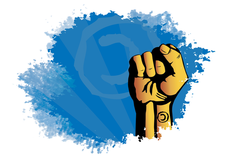The Story of the GPL
Copyleft

The GNU General Public License was born of the simple idea that freedom matters. Yet this simple tool for protecting freedom has another important feature that makes it even more powerful, and that is the ability to build communities.
The scene is 1983, and the high tech world is changing. Computers have been around in some form for a generation, but they are rapidly evolving from the room-sized behemoths of the past into smaller, more versatile systems. Competition is increasing and prices are dropping. And as prices drop, hardware vendors look for other sources of revenue. Corporations start to think of software as a product – independent of the hardware platform. Whole companies, like Microsoft, rise to prominence selling software alone and don't even bother with hardware.
Through this era, the companies that sold software started to become very particular about the rules for using that software, and source code started to become something like a trade secret. When you bought software, you didn't really own anything. You bought a license to use an executable binary, and you didn't even have a good way of knowing what was on that binary.
This new reality was not appealing to the community of programmers who were accustomed to tinkering with computers – in fact, the ability to shape, direct, and modify programs was the main thing they liked about computers. Many were paid handsomely for becoming part of the corporate computer industry, but a few held fast.
[...]
Buy this article as PDF
(incl. VAT)
Buy Linux Magazine
Subscribe to our Linux Newsletters
Find Linux and Open Source Jobs
Subscribe to our ADMIN Newsletters
Support Our Work
Linux Magazine content is made possible with support from readers like you. Please consider contributing when you’ve found an article to be beneficial.

News
-
Parrot OS Switches to KDE Plasma Desktop
Yet another distro is making the move to the KDE Plasma desktop.
-
TUXEDO Announces Gemini 17
TUXEDO Computers has released the fourth generation of its Gemini laptop with plenty of updates.
-
Two New Distros Adopt Enlightenment
MX Moksha and AV Linux 25 join ranks with Bodhi Linux and embrace the Enlightenment desktop.
-
Solus Linux 4.8 Removes Python 2
Solus Linux 4.8 has been released with the latest Linux kernel, updated desktops, and a key removal.
-
Zorin OS 18 Hits over a Million Downloads
If you doubt Linux isn't gaining popularity, you only have to look at Zorin OS's download numbers.
-
TUXEDO Computers Scraps Snapdragon X1E-Based Laptop
Due to issues with a Snapdragon CPU, TUXEDO Computers has cancelled its plans to release a laptop based on this elite hardware.
-
Debian Unleashes Debian Libre Live
Debian Libre Live keeps your machine free of proprietary software.
-
Valve Announces Pending Release of Steam Machine
Shout it to the heavens: Steam Machine, powered by Linux, is set to arrive in 2026.
-
Happy Birthday, ADMIN Magazine!
ADMIN is celebrating its 15th anniversary with issue #90.
-
Another Linux Malware Discovered
Russian hackers use Hyper-V to hide malware within Linux virtual machines.

